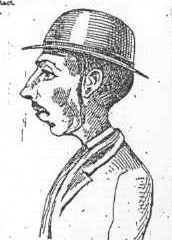
Home Index to Stories Famous Crimes Picture Archive
Percy LeFroy Mapleton
On a Monday afternoon, 27 June 1881, a murder was committed on the 2 o'clock express railway train travelling from London Bridge to Brighton. A regular traveller and coin dealer by the name of Isaac Gold entered a first-class smoking compartment of the third carriage, and was later joined by a young man, Percy LeFroy Mapleton. When the train reached Preston Park, Percy Mapleton emerged in a blood-stained and dishevelled condition, stating that he had been attacked on the journey. There was a watch chain protruding from his shoe. He was then taken further on down the line to Brighton, escorted by Richard Gibson, the ticket collector at Preston Park. At Brighton station, Mapleton maintained to Henry Anscombe, the station master, and to Police Inspector Gibson, that he had been shot and wounded during his journey. He was searched and was found to have two Hanoverian medals in his pockets, similar to coins which had also been earlier in the blood-stained railway compartment.
Nobody was satisfied with Mapleton's account of himself, but, presuming that nobody had left the moving carriage after the train's last stop at East Croydon, the police concluded that the young man might have been attempting suicide, which was then a criminal offence. He was taken to the police station where Detective Constable Howland interviewed him and took details of his alleged assailants, before passing him on to the hospital where his wounds, which were very much less serious than the amount of blood would first suggest, were treated. He was then, as a precaution, taken back to his home in Wallington, Surrey by Detective Sergeant George Holmes, but, during this journey, a telegram from the Station Master at Balcombe, an intermediate station on the line, arrived which changed the situation dramatically, 'Man found dead this afternoon in tunnel here. Name on papers "I Gold". He is now lying here. Reply quick.'
Holmes left Mapleton, who was becoming the prime suspect in a murder enquiry, at Mapleton's home for a period, during which he escaped, and the hunt to re-capture him was notable for the Director of Criminal Intelligence, Howard Vincent's appeal to the press for their help. The Daily Telegraph (1 July 1881) published the police description of Mapleton as:
‘Age 22, middle height, very thin, sickly appearance, scratches on throat, wounds on head, probably clean shaved, low felt hat, black coat, teeth much discoloured.’
In an age when images were rare compared to the present day, the Victorians were often far more adept at describing people verbally than we could probably manage today, and the Mapleton case gave the Daily Telegraph much scope for expanding on the police description more graphically:
‘He is very round shouldered, and his thin overcoat hangs in awkward folds about his spare figure. His forehead and chin are both receding. He has a slight moustache, and very small dark whiskers. His jawbones are prominent, his cheeks sunken and sallow, and his teeth fully exposed when laughing. His upper lip is thin and drawn inwards. His eyes are grey and large. His gait is singular; he is inclined to slouch and when not carrying a bag, his left hand is usually in his pocket. He generally carries a crutch stick.’
| But far more significantly, the Daily Telegraph published an artist's impression of Mapleton by using the assistance of a person who knew the young man well. This was the first time that such a picture had been used in this way by any newspaper, and it created enormous public interest. This public interest resulted in an informant going to Scotland Yard and giving information to Detective Inspector Donald Swanson who then arrested Mapleton in Stepney. |
 |
Home Famous Crimes Index to Stories Contact Us Picture Gallery